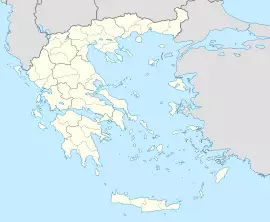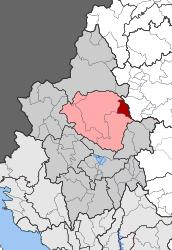Vovousa Βοβούσα or Βωβούσα | |
|---|---|
.jpg) View of Vovousa | |
| Coordinates: 39°56′N 21°03′E / 39.933°N 21.050°E | |
| Country | Greece |
| Administrative region | Epirus |
| Regional unit | Ioannina |
| Municipality | Zagori |
| • Municipal unit | 51.029 km2 (19.702 sq mi) |
| Population (2011)[1] | |
| • Municipal unit | 115 |
| • Municipal unit density | 2.3/km2 (5.8/sq mi) |
| Time zone | UTC+2 (EET) |
| • Summer (DST) | UTC+3 (EEST) |
| Vehicle registration | ΙΝ |
Vovousa (Greek: Βοβούσα or Βωβούσα, Aromanian: Baiesa or Baiasa) is a village and a former community in the Ioannina regional unit, Epirus, Greece. Since the 2011 local government reform it is part of the municipality Zagori, of which it is a municipal unit.[2] The municipal unit has an area of 51.029 km2.[3] It is one of the original Zagori villages.[4] Population 115 (2011).[1] The name possibly derives from "Voiousa" or "Vovousa" (alternative names for the Aoos river[5]) related to the Greek word "vous" (Greek: ΒOYΣ, adjective BOΪOΣ) for "bull". Vovousa is a traditional Aromanian-speaking settlement.
Geography
Vovousa is located on the river Aoos and is one of the easternmost villages of Zagori. It is also located near the National Park of Valia Kalda. The single-arched stone bridge of Misios was built in 1748 with a donation by Alexis Mitsios from Vitsa.[6]
History
Vovousa was considered among the largest villages in Zagori.[5] After the submission of Zagori to the Turks in 1821, following the fall of Ali Pasha and the Greek War of Independence Vovousa became impoverished due to Albanian raids and was nearly deserted. Most of its inhabitants moved in the 19th century to the vicinity of Serres in Macedonia.[5] The village was burnt by the Germans on 23 October 1943.[7]
References
- ^ a b c "Απογραφή Πληθυσμού - Κατοικιών 2011. ΜΟΝΙΜΟΣ Πληθυσμός" (in Greek). Hellenic Statistical Authority.
- ^ Kallikratis law Greece Ministry of Interior (in Greek)
- ^ "Population & housing census 2001 (incl. area and average elevation)" (PDF) (in Greek). National Statistical Service of Greece.
- ^ A. Kathareios (Inspector of the 1st educational region of Epirus) Report of Inspection of Zagorohoria in 1913
- ^ a b c Λαμπρίδης Ιωάννης "Ζαγοριακά", Τυπογραφείον Αυγής, Αθήνα, 1870
- ^ Βασίλης Μηνακάκης (2006). Ζαγοροχώρια. Explorer. p. 139.
It is also located near the National Park of Valia Kalda. The single-arched stone bridge of Mitsios was built in 1748 with a donation by Alexis Mitsios from Vitsa
- ^ Βασίλης Μηνακάκης (2006). Ζαγοροχώρια. Explorer. p. 139.
The village was burnt by the Germans on 23 October 1943
External links

